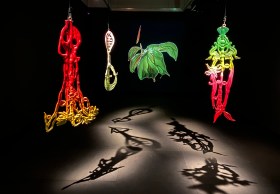When the Communicating the Museum conference gets under way in Sydney on Tuesday 4 November, before progressing to Melbourne on Sunday 9 November, it will be the first time this fourteen-year-old international ideas-based event for arts professionals is held in the southern hemisphere.
‘I love it. It’s the best arts communication conference there is,’ said Miranda Carroll, Director of Communications, Los Angeles County Museum of Art (LACMA).
This year’s Communicating the Museum conference is Carroll’s fourth. She values it for the depth of dialogue and the real connections it enables.
‘We don’t see our colleagues in the museum field as competitors we see them as allies and people to collaborate with,’ Carroll said.
She would know. In Communicating the Museum’s Art Everywhere masterclass session on Thursday 6 November, Carroll speaks with Brooke Molinaroli, Dallas Museum of Art, and Gordon Montgomery, Art Institute of Chicago, about a nation-wide arts initiative using billboards, bus shelters, taxi-tops, subway signs and other outdoor media presentations in which they recently collaborated, along with NYC’s Whitney Museum and the National Gallery, DC.
Pioneered in the UK, and picked up by the Outdoor Advertising Association of America, Art Everywhere required each participating museum to select twenty of their greatest works, which they posted on a special website for the public to vote on. On 4 August, the top 58 works were featured at the digital spectacular that is Times Square, New York. For a month, the works were also displayed across 50,000 sites in the United States.
‘You might find something like our Mappelthorpe portrait of two gentlemen in the middle of the desert on a highway going across Arizona, of you would see a very beautiful Georgia O’Keefe flower right in the middle of Times Square,’ Carroll explained.
‘We had this blipper which you could hold up at some of the smaller presentations like bus shelters – and a bit like the QR code – it would come up with information about that picture and tell you more about where it was from and a little bit of history about the painting and the artist.
‘We got some really great feedback,’ she said. ‘People really seemed to find solace in works being shown in unusual areas. It was a delight.’
With active Snapchat, Instagram, Facebook and Twitter accounts, as well as having an in-house blog and being a hotspot for Miranda July’s somebodyapp, LACMA’s social media strategies means Carroll has plenty to share about how art institutions mobilise knowledge across multiple platforms.
‘A lot of people don’t really know who we are or what we have here on show. I don’t think people really understand the range and breadth of our permanent collection,’ Carroll said.
‘It’s really important for our social media to promote our permanent collection and show what a variety of things we have on display here. We’ve got something for everyone,’ Carroll said.
‘Museums especially need to be very nimble on multi platforms and get their message out in different ways.’
Enabled by social media, the enormous reach of museums and art galleries appears to be physically recalibrated in record-breaking attendance levels.
In Is Elitism Dead? a face-to-face conversation between Liz Ann MacGregor, Director of Museum of Contemporary Art, Australia (MCA) and The Hon. Troy Grant, MP, NSW Minister for the Arts, conducted at Communicating the Museum on Thursday 6 November, the speakers grapple with the anachronistic perceptions of art institutions vis-à-vis their new-found popularity.
‘I think we can show that elitism is dead in the range and numbers of people coming to galleries now,’ MacGregor said.
MacGregor chose the topic for her discussion with the Arts Minister based on his own story.
‘He’s quite new in the position, he’s an ex-policeman, he perhaps isn’t immediately the person you would imagine would want to take on the arts,’ she said.
‘The fact that Troy’s not a member of the arts elite is a really good thing because it challenges the stereotype of what kind of person is going to be interested in the arts. It’s terrific to have someone in that position coming at it from a very different outlook and obviously passionate about it.’
MacGregor is looking forward to the opportunity the conference presents to connect with people, while hosting events on home soil.
‘It’s always about meeting people and about saying look what an incredible place we have here! So there’s quite a bit of showing off and learning from others as well. We’re always wanting to find out how we can do things better.’
One major conference drawcard presented by the MCA is their Digital Excursions program.
‘We recently had curators here from MOMA and they were really impressed with our National Centre of Creative Learning where we have the technology and now the lessons and content to engage with schools digitally right across NSW and Victoria,’ MacGregor explained.
‘So if you’re a kid in Dubbo and you want to study art, you can actually do a digital excursion to the MCA. We don’t know anywhere else that’s doing that yet. I think we’ve got a bit of a world first here.’
For MacGregor, education is an integral part of the MCA’s communication strategies.
‘It’s important on two levels,’ she said. ‘It’s important on the formal level, so that we’re connecting with young people who are learning at school.
‘We’re doing some very interesting work with indigenous schools as well as connecting young people with artists in their studios, for example, which is very exciting because they’re role models. Successful Aboriginal artists working in Brisbane or Sydney or Melbourne can really act as catalysts for young people to want to engage with school.
‘But also generally just being able to convey what it is that happens in an art museum is very exciting. There’s a lot of evidence that shows that if people see things digitally then they want to come and experience the real thing as well,’ MacGregor said.
The MCA’s boundary-crossing innovations exemplify how Australian art institutions are brokering complex collaborations that reflect a broader international trend – and why it is the ideal time for Communicating the Museum to advance to Australian shores.
Mark Goggin, Director of Sydney Living Museums, is part of the team responsible for bringing Communicating the Museum to Australia.
According to Goggin, there’s been a shift away from introspection within art institutions and a concurrent momentum towards museums moving beyond their core focus.
‘The Louvre’s doing a regional museum, the V&A’s getting a TV channel, the Rijksmuseum is giving its artwork to artists to create work – in addition to the MCA’s projects in Sydney – so there’s some really interesting models about how to broker genuine and real collaborations beyond the boundaries of the institution,’ he said.
Goggin sees the current historical climate as representing a ‘tipping point’ for museums and galleries and one which Australian institutions are particularly well-placed to take advantage of.
‘Being a relatively bold country unconstrained by history, literature and politics, with generous resources and living standards, relatively speaking, I think we’re well positioned to embrace globalisation in communications and knowledge and technology,’ Goggin said.
‘We’re not as restrained as other countries, particularly when you’re thinking about European traditions and histories and collections which are sometimes thousands of years and they’re much more slow-moving in the way that they approach their knowledge-collections,’ Goggin noted.
Our nation’s freedoms and opportunities informed the CEO of Agenda Communications, Corinne Estrada’s decision to choose Optimism for the theme of Communicating the Museum 2014.
‘Corinne spends a bit of time in a city or region before she hits on a theme,’ Goggin explained. ‘She was at the opening of the Yoko Ono exhibition at the MCA when she first arrived and she couldn’t believe the optimism of that event, the energy in the room, the response to the artist and how impassioned people were.
‘Corinne said even the French here are more optimistic – what is it?! So amongst a range of things she started to ask what does optimism mean for communication? What does it mean for Australian thinking and identities?’
For Goggin, Communicating the Museum is unique for the way in which it reinvents modalities for expressing creative ideas and new thinking in a Ted X-type format, focuses on where the new themes and trends are and combines museum professionals and non-museum professionals to create cross-fertilisation.
As host nation, Australia is the first site to bring together an array of institutions from northern and southern hemispheres with representatives coming from New Zealand, Singapore, Hong Kong, Europe and America.
‘I’m interested in seeing these two groups meet and connect and seeing how they surprise each other,’ Goggin said.
As someone who has witnessed the results of a positive rebranding in the transformation of the Historic Houses Trust to Sydney Living Museums, Goggin is also interested in how the conference will discuss the post-brand era.
‘Brands are for cows, stories are for people,’ he says. ‘Purpose has become a much more common way of describing the platform that museums need to create for the audiences of the future.
‘We’re moving to another era of being able to embody the complexities within institutions. Cultural institutions by their nature are complex intellectual places and focus on the minutiae of what’s valuable in a custodial sense and there’s a great national and international interest in that.
‘The key is how to bridge that complexity without losing control. And there’s some really interesting examples of that that are coming up in the conference,’ Goggin said.
‘Communicating the Museum is a great way for Australian museums and galleries to be involved in directing this conversation in the future.’
Communicating the Museum 14th International Conference: Optimism
4 – 8 November, Sydney
9 – 12 November, Melbourne
12 November, Tasmania (optional)
Conference registration is here.





